阴瑜伽体式解说
- 格式:doc
- 大小:41.00 KB
- 文档页数:32
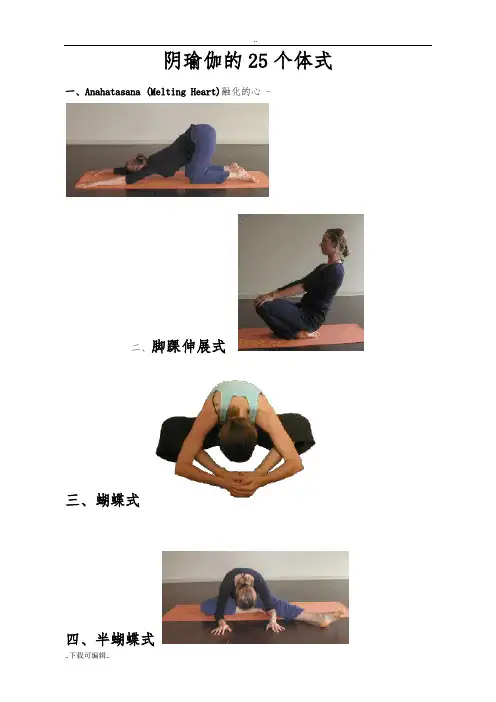
..阴瑜伽的25个体式一、Anahatasana (Melting Heart)融化的心 -二、脚踝伸展式三、蝴蝶式四、半蝴蝶式..其他选择:可以将伸直的腿向后折叠, 可让后腿跟腱更好伸展; 另一侧手臂伸展手够到脚趾或将肩部降低,重点在侧腰部; 手肘放在大腿上头在另一侧手上可以增加脊柱的扭转(或为了更加放松学员可以将手臂放在伸展腿的一侧) 另一条手臂放在背后,或伸过头顶 ,并且旋转胸部朝向天花板方向.这加深了一侧肋骨和脊柱的感觉;只有在膝盖无任何不适的情况下,才可以弯曲膝盖脚踝到英雄式(腿折叠放于臀部下方).五、骆驼式六、猫拉尾式替代体式:•简易变体是用手臂支撑,如图所示;•难度加大的变体是, 肩膀向后朝向脚底. 这个变体成为一个躺着的扭转后弯体式. 关键是把脚拉伸远离臀部(许多学员做不到这点).七、毛毛虫八、婴儿式九、悬挂式十、鹿十一、龙1.龙式变体:2.第一个选择是简单向下的冲刺式,叫做婴儿龙式3.接下来的变式是把手臂或手掌放在前侧大腿上, 并提升胸部 - 这会增加髋部承重. 这就是"高飞龙式";4.一个加深的变式, 低飞龙式,双手放在前脚内侧 (确保脚不会向内滑动到鸽子式) 双手先前挪动, 放低髋部.学员可以手肘落地来加深体式, 或手肘落在垫子或瑜伽砖上、;5."扭转龙式" - 手向一侧推膝盖并将胸部转向天花板方向;6."翼龙式" - 双手着地, 膝盖向外摆动几次, 转动到前脚外侧的极限,然后膝盖放低在那里保持. 可以手肘落地来或手肘落在垫子或瑜伽砖上;1."大跨步龙式" - 锻炼到脚踝. 从婴儿龙式开始, 让前腿膝盖最大程度向前并/或后脚跟向后滑动, 直到脚跟刚要抬离地面;2."劈腿龙式" - 最深度的伸展臀部屈肌. 伸展两腿向两侧劈开. 学员可以在前侧臀部下垫上毯子支撑, 便于平衡和减轻重量; 这样可以放松肌肉. 学员可以立直上身或上身折叠向前会有不同的感觉; 3."火呼吸龙式(Fire-breathing Dragon翻译得有点生硬了,暂时没想到更好的名称)" - 在以上的任一变体中,脚趾瞪地抬高膝盖, 伸展腿部. 这会增加髋部承重, 加强伸展.十二、蜻蜓(aka Straddle)其他选择:•用长枕垫高臀部;•可以将双手放在背后,或手肘枕在长枕上;•一条腿弯曲收回来增加脊柱和腿后侧的伸展.如果膝盖感到不适,收紧四头肌锁住膝关节,或让双腿离的近些;•如果腿后侧跟腱太紧, 屈膝并在大腿下方垫上长枕;•双腿可以打开90度角,对于程度好的学员打开120度角. 没有必要完全劈开双腿到180度;•高级学员可以俯身向一侧,手臂放松在腿的两侧;•如果你接近地板,可以用长枕垫在下巴下;•如果感到头部沉重颈部无法支撑,可以用手支撑;•对于身体僵硬的学员, 要更多的屈膝!脚内侧平贴在地板上也可以;•可以进行扭转 (类似扭转的单腿背部前屈伸展式) 一腿屈膝折叠,胸部转向天花板(高级学员可以双手抓脚);•也可以做坐立扭转 (帮助刺激肩胛骨下方上身的经络).十三、青蛙其他选择:1.蝌蚪式: 从婴儿式开始, 分开两膝, 但臀部不要离开脚后跟;2.半青蛙式: 臀部向上抬起, 直到与膝盖在一条直线;双脚相对;3.全青蛙式:双脚分开与膝盖同宽.4.可以每次伸展一侧手臂: 这样安全些. 另一侧手臂弯曲让头枕在小臂上. 柔韧的学员可以同时伸展双臂;5.如果腿内侧或髋部的压力太强烈可以让臀部向前移动;6.另一选择,脚趾并在一起,臀部向后移动;7.可以在身下垫上长枕, 让上身放松;8.如果肩膀不舒服, 手臂向两侧分开的宽一些。
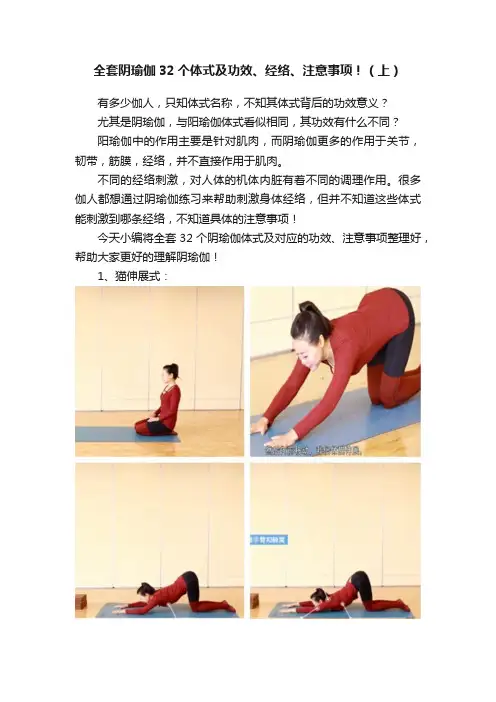
全套阴瑜伽32个体式及功效、经络、注意事项!(上)有多少伽人,只知体式名称,不知其体式背后的功效意义?尤其是阴瑜伽,与阳瑜伽体式看似相同,其功效有什么不同?阳瑜伽中的作用主要是针对肌肉,而阴瑜伽更多的作用于关节,韧带,筋膜,经络,并不直接作用于肌肉。
不同的经络刺激,对人体的机体内脏有着不同的调理作用。
很多伽人都想通过阴瑜伽练习来帮助刺激身体经络,但并不知道这些体式能刺激到哪条经络,不知道具体的注意事项!今天小编将全套32个阴瑜伽体式及对应的功效、注意事项整理好,帮助大家更好的理解阴瑜伽!1、猫伸展式:A:生理层面:1、很好的伸展上背和中背部;2、柔软脊柱;3、打开肩部;4、放松心臟;B:经络层面:1、沿着脊柱走膀胱经;2、手臂的经络,尤其是心包经;3、刺激肺经;C:注意事项:如果颈部不好,这会造成损伤;2、蝴蝶式:A:生理层面:1、很好的伸展背部;2、后腿筋得到更好的拉伸;3、对肾臟和不活跃的腺体很好,对那些遭受泌尿疾病的人,非常有帮助;4、这个体式可以消除男性睾丸的沉重感,对女性的经期规则化,卵巢功能有功效,也有助于分娩;B:经络层面:1、腿外侧的胆经和通过下背部影响到贯穿脊柱的膀胱经;2、如果双脚向内靠近会阴会感到大腿内侧的伸展,刺激肾经和肝经;C:注意事项:1、坐立前屈对骨盆和膝盖施压---这可以加重坐骨神经痛。
如果有这样的问题,抬高臀部时膝盖低于臀部;2、怀孕妇女,也可以做,双腿应该向外展开,给腹部留出空间;3、如果颈椎骨突出或不是正常的曲度,应避免这个体式;4、可在饭后练习,但是注意头不要向前接触地板,这样会给腹部太多压力;5、如果双脚向内,紧张的内收肌或紧张的下背部可能会阻碍上身前屈,让双脚离身体远一些;6、许多让人会自动的进入紧张的蝴蝶式,因为他们受到“阳瑜伽”的练习,鼓励他们将双脚放的远一些,双腿形成一个菱形。
3、半蝴蝶A:生理层面:1、不需要后腿筋松弛,就可很好的伸展下背部;2、尤其针对后背部的韧带;3、刺激肝臟和肾臟,帮助消化;4、放松脊柱;5、伸展内侧膝盖空间;B:经络层面:1、刺激膀胱经;2、刺激肝肾经络;C:注意事项:1、和蝴蝶式相同;A:生理层面:1、很好的灵活脊柱;2、伸展上背部;3、刺激内脏器官,帮助消化;4、建立双腿力量;5、刺激淋巴系统;6、打开腰椎和骶骨。
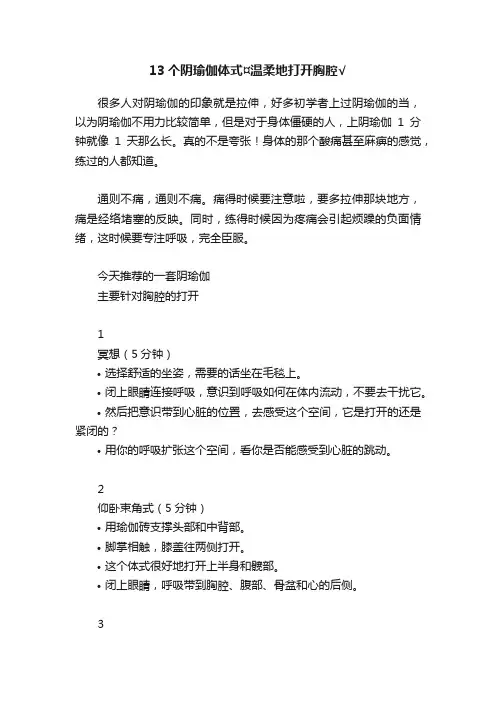
13个阴瑜伽体式¤温柔地打开胸腔√很多人对阴瑜伽的印象就是拉伸,好多初学者上过阴瑜伽的当,以为阴瑜伽不用力比较简单,但是对于身体僵硬的人,上阴瑜伽1分钟就像1天那么长。
真的不是夸张!身体的那个酸痛甚至麻痹的感觉,练过的人都知道。
通则不痛,通则不痛。
痛得时候要注意啦,要多拉伸那块地方,痛是经络堵塞的反映。
同时,练得时候因为疼痛会引起烦躁的负面情绪,这时候要专注呼吸,完全臣服。
今天推荐的一套阴瑜伽主要针对胸腔的打开1冥想(5分钟)•选择舒适的坐姿,需要的话坐在毛毯上。
•闭上眼睛连接呼吸,意识到呼吸如何在体内流动,不要去干扰它。
•然后把意识带到心脏的位置,去感受这个空间,它是打开的还是紧闭的?•用你的呼吸扩张这个空间,看你是否能感受到心脏的跳动。
2仰卧束角式(5分钟)•用瑜伽砖支撑头部和中背部。
•脚掌相触,膝盖往两侧打开。
•这个体式很好地打开上半身和髋部。
•闭上眼睛,呼吸带到胸腔、腹部、骨盆和心的后侧。
3猫式/牛式伸展(2分钟)•这个体式是过渡体式,连接前后两个阴瑜伽体式,后面的体式之间都可以做这个体式。
•吸气时尾骨向上、腹部下沉、胸腔向上,呼气时卷尾骨、收肚脐、低头弓背。
•缓慢地重复几次,给脊柱热身。
4婴儿式(砖块辅助 4分钟)•臀部坐脚跟来到婴儿式。
•用1-2个瑜伽砖在手臂下方,前额着地,拉伸肩膀。
•呼吸,完全地臣服。
5融心式(3分钟)•这个体式叫融心式是因为它拉伸胸腔,扩展心脏和肺部空间。
•来到四脚板凳式,双手往前走。
•保持髋部在膝盖前方一点,胸腔下沉找地面。
•深呼吸,感受拉伸。
•从体式出来时,先回到婴儿式休息几分钟。
6放松腋窝(4分钟)•一个砖块放在卷起的瑜伽垫下方。
•左侧卧,砖块在腋窝下方。
•这个体式主要针对心经和肺经,手臂撑着头,放松呼吸。
•4分钟之后做几次猫式/牛式伸展,在换边重复。
7人面狮身式•趴下来,手肘撑地,对齐肩膀。
•脸部放松,看前方,不是向下,这样脖子没有压力。
•双腿和臀部放松,也许会感受到下背部的挤压,如果太严重,可以趴下来放松。
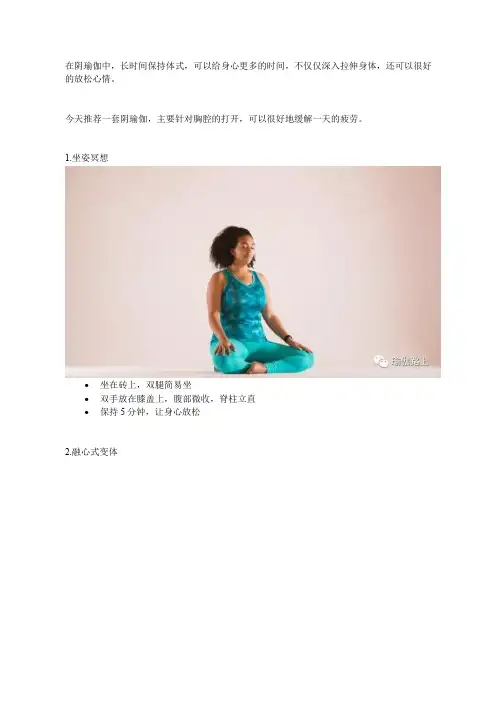
在阴瑜伽中,长时间保持体式,可以给身心更多的时间,不仅仅深入拉伸身体,还可以很好的放松心情。
今天推荐一套阴瑜伽,主要针对胸腔的打开,可以很好地缓解一天的疲劳。
1.坐姿冥想∙坐在砖上,双腿简易坐∙双手放在膝盖上,腹部微收,脊柱立直∙保持5分钟,让身心放松2.融心式变体∙膝盖、小腿、脚背贴地∙膝盖与髋同宽,手肘放在砖上∙额头放在砖中间的毛毯上∙保持3-5分钟3.侧卧∙侧卧,弯曲膝盖,左肋骨和腋窝下方垫个抱枕∙左手肘撑地,右手撑地,保持3分钟,换边4.婴儿式∙膝盖并拢,大脚趾并拢∙臀部向后找脚跟,胸腔折叠∙额头和双手放在地面∙保持3-5分钟4.卧英雄式变体∙从金刚坐,膝盖分开∙躺在瑜伽砖支撑的抱枕上∙保持3-5分钟5.支撑鱼式∙仰卧,在上背部放个瑜伽砖∙双手互抱手肘,头放在砖块上∙保持3-5分钟6.支撑桥式∙仰卧,弯曲膝盖∙双脚对齐膝盖,在骶骨下方垫个瑜伽砖∙保持3-5分钟7.支撑桥式变体∙在上一个体式基础上,双腿伸直∙保持3-5分钟8.仰卧开髋∙仰卧,弯曲膝盖,2个膝盖分别90°∙右大腿垂直上半身,左大腿和身体一条直线∙左膝盖往下找地,保持3-5分钟,换边9.人面狮身式∙俯卧,双腿打开与髋同宽∙双手手肘撑地,对齐肩膀∙小手臂平行,保持3-5分钟10.海豹式∙从上一个体式,双手稍微向后一点∙然后保持脊柱延展,伸直双手∙保持3-5分钟11.犁式∙仰卧,双手在身体两侧撑地∙让臀部上提,双脚来到头顶上方着地∙保持3-5分钟12.快乐婴儿式∙仰卧,弯曲膝盖∙膝盖打开,双手抓脚,拉膝盖靠近地面∙保持3-5分钟13.挺尸式∙仰卧,双腿打开与髋同宽∙双手打开掌心朝上∙保持5-10分钟特别是在心情起伏比较大的日子里,给自己来这么一套打开心轮的阴瑜伽练习,让自己完全融化在垫子上,让心完全柔软下来,心就安宁了,而安宁背后,是平静的喜悦。
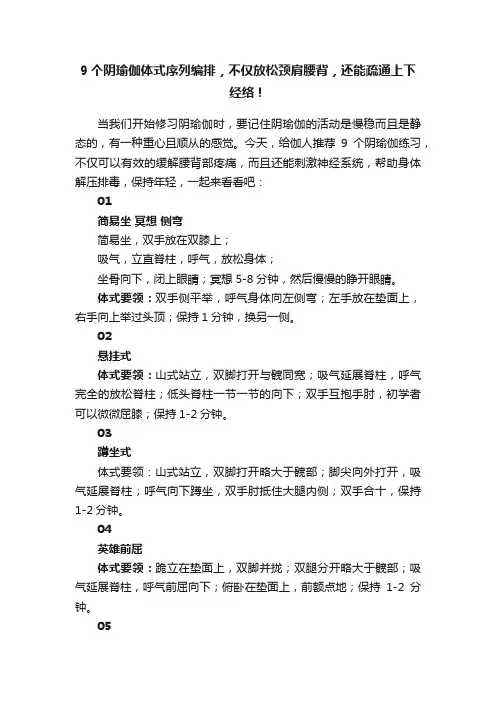
9个阴瑜伽体式序列编排,不仅放松颈肩腰背,还能疏通上下经络!当我们开始修习阴瑜伽时,要记住阴瑜伽的活动是慢稳而且是静态的,有一种重心且顺从的感觉。
今天,给伽人推荐9个阴瑜伽练习,不仅可以有效的缓解腰背部疼痛,而且还能刺激神经系统,帮助身体解压排毒,保持年轻,一起来看看吧:01简易坐冥想侧弯简易坐,双手放在双膝上;吸气,立直脊柱,呼气,放松身体;坐骨向下,闭上眼睛;冥想5-8分钟,然后慢慢的睁开眼睛。
体式要领:双手侧平举,呼气身体向左侧弯;左手放在垫面上,右手向上举过头顶;保持1分钟,换另一侧。
02悬挂式体式要领:山式站立,双脚打开与髋同宽;吸气延展脊柱,呼气完全的放松脊柱;低头脊柱一节一节的向下;双手互抱手肘,初学者可以微微屈膝;保持1-2分钟。
03蹲坐式体式要领:山式站立,双脚打开略大于髋部;脚尖向外打开,吸气延展脊柱;呼气向下蹲坐,双手肘抵住大腿内侧;双手合十,保持1-2分钟。
04英雄前屈体式要领:跪立在垫面上,双脚并拢;双腿分开略大于髋部;吸气延展脊柱,呼气前屈向下;俯卧在垫面上,前额点地;保持1-2分钟。
05猫牛式体式要领:跪立在垫面上,大腿手臂垂直垫面;吸气抬头颈椎、胸椎、腰椎一节一节延展;呼气,骨盆向后转动;腰椎、胸椎、颈椎一节一节延展;重复练习3-5组。
06方形式体式要领:坐立在垫上,将左脚放在右大腿上;右脚在左膝下方;吸气延展脊柱,呼气身体慢慢前屈向下;保持2-3分钟,换另一侧。
07蝴蝶式体式要领:坐立在垫面上,双脚并拢;双腿向外打开,吸气向上立直脊柱;呼气慢慢的前屈向下;保持2-3分钟。
08坐角式体式要领:双脚打开适当的距离;吸气向上立直脊柱,呼气放松;身体前屈向下,双手在垫面上;保持2-3分钟。
09倒箭式体式要领:臀部双腿靠墙仰卧在垫面上;双手放在身体的两侧;闭上眼睛,保持3-5分钟。
- END -。
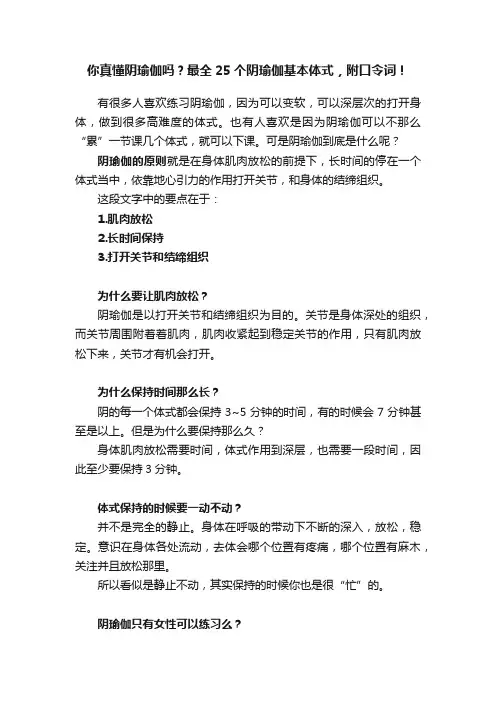
你真懂阴瑜伽吗?最全25个阴瑜伽基本体式,附口令词!有很多人喜欢练习阴瑜伽,因为可以变软,可以深层次的打开身体,做到很多高难度的体式。
也有人喜欢是因为阴瑜伽可以不那么“累”一节课几个体式,就可以下课。
可是阴瑜伽到底是什么呢?阴瑜伽的原则就是在身体肌肉放松的前提下,长时间的停在一个体式当中,依靠地心引力的作用打开关节,和身体的结缔组织。
这段文字中的要点在于:1.肌肉放松2.长时间保持3.打开关节和结缔组织为什么要让肌肉放松?阴瑜伽是以打开关节和结缔组织为目的。
关节是身体深处的组织,而关节周围附着着肌肉,肌肉收紧起到稳定关节的作用,只有肌肉放松下来,关节才有机会打开。
为什么保持时间那么长?阴的每一个体式都会保持3~5分钟的时间,有的时候会7分钟甚至是以上。
但是为什么要保持那么久?身体肌肉放松需要时间,体式作用到深层,也需要一段时间,因此至少要保持3分钟。
体式保持的时候要一动不动?并不是完全的静止。
身体在呼吸的带动下不断的深入,放松,稳定。
意识在身体各处流动,去体会哪个位置有疼痛,哪个位置有麻木,关注并且放松那里。
所以看似是静止不动,其实保持的时候你也是很“忙”的。
阴瑜伽只有女性可以练习么?要知道阴瑜伽的创始人是个男神哦,只不过一听到“阴”这个字很容易把它和“女性”联系在一起。
其实男性同样需要阴瑜伽。
阴阳平衡是针对全人类的!当你发现你可以连续做好多Vinyasa却无法散盘静坐;你可以不停的奔跑,却没办法静止一秒……这时你就需要阴瑜伽来拯救你了。
阴瑜伽这么好,每个人都可以练习么?原则上是的。
可是实际上呢?身体特别柔软的人是不应该继续做阴瑜伽的。
天生柔软的人,可能激素分泌不均衡,关节处不稳定,肌肉无力等,导致很容易扭伤。
也是因为关节缝隙大,导致血液里面钙的含量降低,很容易让关节恶化。
这类人群就要加强力量练习了。
阴瑜伽虽好,但也要量力而行哦。
可话说回来,到底阴瑜伽可以给我们带来什么,为什么我们需要阴瑜伽这类的练习?身体变柔软阴瑜伽的练习方式是通过伸展骨与骨之间连接的结缔组织来让身体变得柔韧。
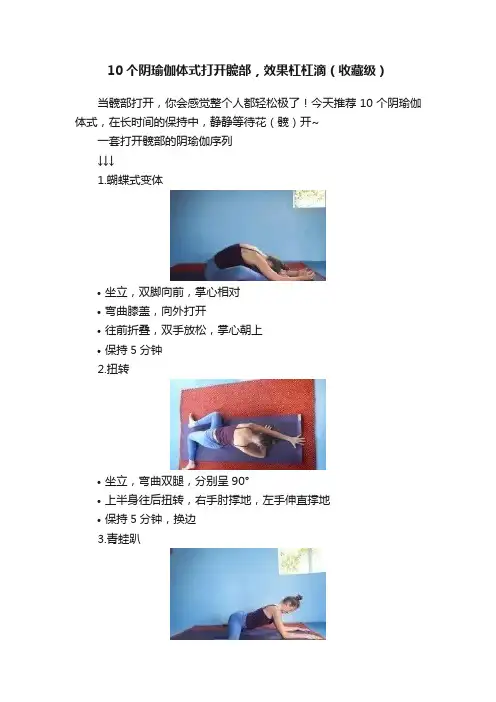
10个阴瑜伽体式打开髋部,效果杠杠滴(收藏级)当髋部打开,你会感觉整个人都轻松极了!今天推荐10个阴瑜伽体式,在长时间的保持中,静静等待花(髋)开~一套打开髋部的阴瑜伽序列↓↓↓1.蝴蝶式变体•坐立,双脚向前,掌心相对•弯曲膝盖,向外打开•往前折叠,双手放松,掌心朝上•保持5分钟2.扭转•坐立,弯曲双腿,分别呈90°•上半身往后扭转,右手肘撑地,左手伸直撑地•保持5分钟,换边3.青蛙趴•膝盖分开,和髋部一条直线•膝盖90度,脚踝90度•手肘撑地,胸腔延展•保持5分钟4.上犬式•趴下来,双手在胸腔两侧•吸气向上推起,大臂外旋,锁骨展开•保持10次呼吸5.双角式变体•双脚打开,一条腿的长度•双手往前延展,指尖点地•保持1分钟•然后弯曲膝盖,臀部向后,大腿平行地面•保持1分钟6.半鸽子式•左腿弯曲在前,脚回勾,小腿平行前面垫子•右腿向后延展,胸腔向上•保持5分钟,换边7.神猴式•左腿向前伸直,右腿向后伸直,脚回勾踩地•髋部摆正,双手撑地,脊柱延展•保持1分钟•然后转动身体向左,左手抓右大腿后侧,右手撑住左大腿前侧•保持1分钟,换边8.坐角式•坐立,双腿往两侧打开,脚回勾•往前折叠,手肘撑地,胸腔贴地•双手在后脑勺合十•保持5分钟9.桥式•仰卧,弯曲膝盖,双脚踩地,对齐膝盖•双手抓脚踝,臀部向上,胸腔打开•保持1分钟10.靠墙束角式•仰卧,臀部贴墙,弯曲膝盖,双脚相对,放在墙上•双手往两侧打开,保持5分钟打开髋部其实就是需要时间和耐心,每天坚持练习,髋部打开指日可待!- 留言有奖 -今日话题:开髋,真的辣么难?说说你的心得~欢迎留言,7月7日12:00前我们将从精选留言中选出1位点最多的幸运粉丝,送出下图瑜伽短裤一条(4色可选)。
以往已获奖者,奖品自动顺延给下一位伽友哦~。
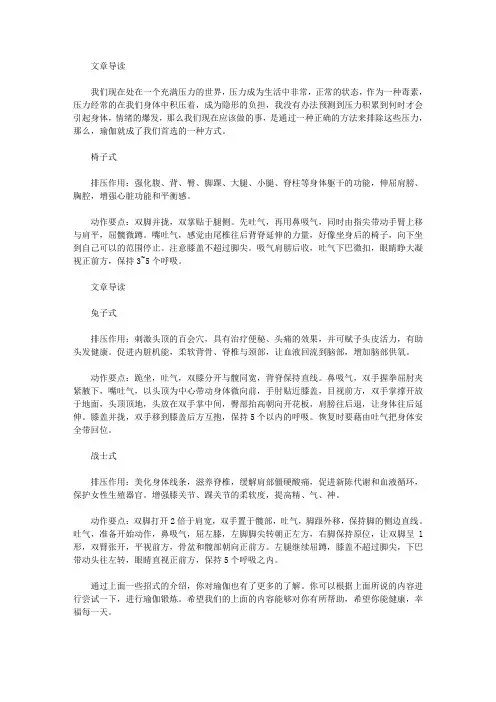
文章导读我们现在处在一个充满压力的世界,压力成为生活中非常,正常的状态,作为一种毒素,压力经常的在我们身体中积压着,成为隐形的负担,我没有办法预测到压力积累到何时才会引起身体,情绪的爆发,那么我们现在应该做的事,是通过一种正确的方法来排除这些压力,那么,瑜伽就成了我们首选的一种方式。
椅子式排压作用:强化腹、背、臀、脚踝、大腿、小腿、脊柱等身体躯干的功能,伸屈肩膀、胸腔,增强心脏功能和平衡感。
动作要点:双脚并拢,双掌贴于腿侧。
先吐气,再用鼻吸气,同时由指尖带动手臂上移与肩平,屈髋微蹲。
嘴吐气,感觉由尾椎往后背脊延伸的力量,好像坐身后的椅子,向下坐到自己可以的范围停止。
注意膝盖不超过脚尖。
吸气肩膀后收,吐气下巴微扣,眼睛睁大凝视正前方,保持3~5个呼吸。
文章导读兔子式排压作用:刺激头顶的百会穴,具有治疗便秘、头痛的效果,并可赋予头皮活力,有助头发健康。
促进内脏机能,柔软背骨、脊椎与颈部,让血液回流到脑部,增加脑部供氧。
动作要点:跪坐,吐气,双膝分开与髋同宽,背脊保持直线。
鼻吸气,双手握拳屈肘夹紧腋下,嘴吐气,以头顶为中心带动身体微向前,手肘贴近膝盖,目视前方,双手掌撑开放于地面,头顶顶地,头放在双手掌中间,臀部抬高朝向开花板,肩膀往后退,让身体往后延伸。
膝盖并拢,双手移到膝盖后方互抱,保持5个以内的呼吸。
恢复时要藉由吐气把身体安全带回位。
战士式排压作用:美化身体线条,滋养脊椎,缓解肩部僵硬酸痛,促进新陈代谢和血液循环,保护女性生殖器官。
增强膝关节、踝关节的柔软度,提高精、气、神。
动作要点:双脚打开2倍于肩宽,双手置于髋部,吐气,脚跟外移,保持脚的侧边直线。
吐气,准备开始动作,鼻吸气,屈左膝,左脚脚尖转朝正左方,右脚保持原位,让双脚呈l 形,双臂张开,平视前方,骨盆和髋部朝向正前方。
左腿继续屈蹲,膝盖不超过脚尖,下巴带动头往左转,眼睛直视正前方,保持5个呼吸之内。
通过上面一些招式的介绍,你对瑜伽也有了更多的了解。
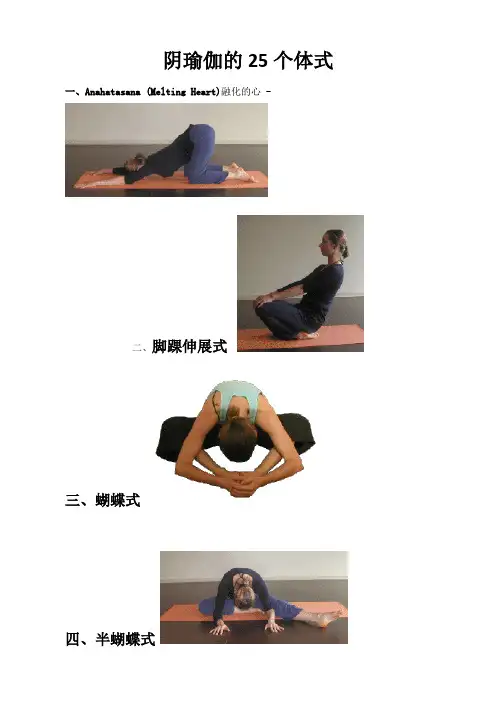
阴瑜伽的25个体式一、Anahatasana (Melting Heart)融化的心 -二、脚踝伸展式三、蝴蝶式四、半蝴蝶式其他选择:可以将伸直的腿向后折叠, 可让后腿跟腱更好伸展; 另一侧手臂伸展手够到脚趾或将肩部降低,重点在侧腰部; 手肘放在大腿上头在另一侧手上可以增加脊柱的扭转(或为了更加放松学员可以将手臂放在伸展腿的一侧) 另一条手臂放在背后,或伸过头顶 ,并且旋转胸部朝向天花板方向.这加深了一侧肋骨和脊柱的感觉;只有在膝盖无任何不适的情况下,才可以弯曲膝盖脚踝到英雄式(腿折叠放于臀部下方).五、骆驼式六、猫拉尾式替代体式:•简易变体是用手臂支撑,如图所示;•难度加大的变体是, 肩膀向后朝向脚底. 这个变体成为一个躺着的扭转后弯体式. 关键是把脚拉伸远离臀部(许多学员做不到这点).七、毛毛虫八、婴儿式九、悬挂式十、鹿十一、龙1.龙式变体:2.第一个选择是简单向下的冲刺式,叫做婴儿龙式3.接下来的变式是把手臂或手掌放在前侧大腿上, 并提升胸部 - 这会增加髋部承重. 这就是"高飞龙式";4.一个加深的变式, 低飞龙式,双手放在前脚内侧 (确保脚不会向内滑动到鸽子式) 双手先前挪动, 放低髋部.学员可以手肘落地来加深体式, 或手肘落在垫子或瑜伽砖上、;5."扭转龙式" - 手向一侧推膝盖并将胸部转向天花板方向;6."翼龙式" - 双手着地, 膝盖向外摆动几次, 转动到前脚外侧的极限,然后膝盖放低在那里保持. 可以手肘落地来或手肘落在垫子或瑜伽砖上;1."大跨步龙式" - 锻炼到脚踝. 从婴儿龙式开始, 让前腿膝盖最大程度向前并/或后脚跟向后滑动, 直到脚跟刚要抬离地面;2."劈腿龙式" - 最深度的伸展臀部屈肌. 伸展两腿向两侧劈开. 学员可以在前侧臀部下垫上毯子支撑, 便于平衡和减轻重量; 这样可以放松肌肉. 学员可以立直上身或上身折叠向前会有不同的感觉; 3."火呼吸龙式(Fire-breathing Dragon翻译得有点生硬了,暂时没想到更好的名称)" - 在以上的任一变体中,脚趾瞪地抬高膝盖, 伸展腿部. 这会增加髋部承重, 加强伸展.--十二、蜻蜓(aka Straddle)其他选择:•用长枕垫高臀部;•可以将双手放在背后,或手肘枕在长枕上;•一条腿弯曲收回来增加脊柱和腿后侧的伸展.如果膝盖感到不适,收紧四头肌锁住膝关节,或让双腿离的近些;•如果腿后侧跟腱太紧, 屈膝并在大腿下方垫上长枕;•双腿可以打开90度角,对于程度好的学员打开120度角. 没有必要完全劈开双腿到180度;•高级学员可以俯身向一侧,手臂放松在腿的两侧;•如果你接近地板,可以用长枕垫在下巴下;•如果感到头部沉重颈部无法支撑,可以用手支撑;•对于身体僵硬的学员, 要更多的屈膝!脚内侧平贴在地板上也可以;•可以进行扭转 (类似扭转的单腿背部前屈伸展式) 一腿屈膝折叠,胸部转向天花板(高级学员可以双手抓脚);•也可以做坐立扭转 (帮助刺激肩胛骨下方上身的经络).十三、青蛙其他选择:1.蝌蚪式: 从婴儿式开始, 分开两膝, 但臀部不要离开脚后跟;2.半青蛙式: 臀部向上抬起, 直到与膝盖在一条直线;双脚相对;3.全青蛙式:双脚分开与膝盖同宽.4.可以每次伸展一侧手臂: 这样安全些. 另一侧手臂弯曲让头枕在小臂上. 柔韧的学员可以同时伸展双臂;5.如果腿内侧或髋部的压力太强烈可以让臀部向前移动;6.另一选择,脚趾并在一起,臀部向后移动;7.可以在身下垫上长枕, 让上身放松;8.如果肩膀不舒服, 手臂向两侧分开的宽一些。
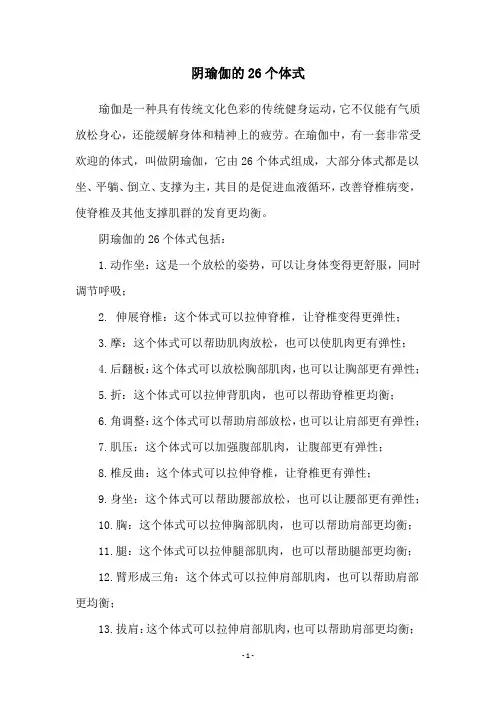
阴瑜伽的26个体式瑜伽是一种具有传统文化色彩的传统健身运动,它不仅能有气质放松身心,还能缓解身体和精神上的疲劳。
在瑜伽中,有一套非常受欢迎的体式,叫做阴瑜伽,它由26个体式组成,大部分体式都是以坐、平躺、倒立、支撑为主,其目的是促进血液循环,改善脊椎病变,使脊椎及其他支撑肌群的发育更均衡。
阴瑜伽的26个体式包括:1.动作坐:这是一个放松的姿势,可以让身体变得更舒服,同时调节呼吸;2. 伸展脊椎:这个体式可以拉伸脊椎,让脊椎变得更弹性;3.摩:这个体式可以帮助肌肉放松,也可以使肌肉更有弹性;4.后翻板:这个体式可以放松胸部肌肉,也可以让胸部更有弹性;5.折:这个体式可以拉伸背肌肉,也可以帮助脊椎更均衡;6.角调整:这个体式可以帮助肩部放松,也可以让肩部更有弹性;7.肌压:这个体式可以加强腹部肌肉,让腹部更有弹性;8.椎反曲:这个体式可以拉伸脊椎,让脊椎更有弹性;9.身坐:这个体式可以帮助腰部放松,也可以让腰部更有弹性;10.胸:这个体式可以拉伸胸部肌肉,也可以帮助肩部更均衡;11.腿:这个体式可以拉伸腿部肌肉,也可以帮助腿部更均衡;12.臂形成三角:这个体式可以拉伸肩部肌肉,也可以帮助肩部更均衡;13.拔肩:这个体式可以拉伸肩部肌肉,也可以帮助肩部更均衡;14.背部:这个体式可以拉伸背部肌肉,也可以帮助背部更均衡;15.峰式:这个体式可以拉伸腰部肌肉,也可以帮助腰部更均衡;16.尚式:这个体式可以拉伸腰部肌肉,也可以帮助腰部更均衡;17.肢形:这个体式可以拉伸肩部、背部、腰部肌肉,帮助肩部、背部和腰部更均衡;18. 三角形:这个体式可以拉伸肩部、背部、腰部肌肉,帮助肩部、背部和腰部更均衡;19.立:这个体式可以加强肩部、背部、腰部肌肉,帮助肩部、背部和腰部更均衡;20.虎式:这个体式可以拉伸腹部肌肉,帮助腹部更均衡;21.利那:这个体式可以拉伸腹部肌肉,帮助腹部更均衡;22.河式:这个体式可以拉伸腿部肌肉,帮助腿部更均衡;23.跷板式:这个体式可以拉伸背肌肉,帮助背部更均衡;24.式:这个体式可以拉伸腹部肌肉,帮助腹部更均衡;25.转腿:这个体式可以拉伸腿部肌肉,帮助腿部更均衡;26.躺式:这个体式可以放松身体,让肌肉更有弹性。
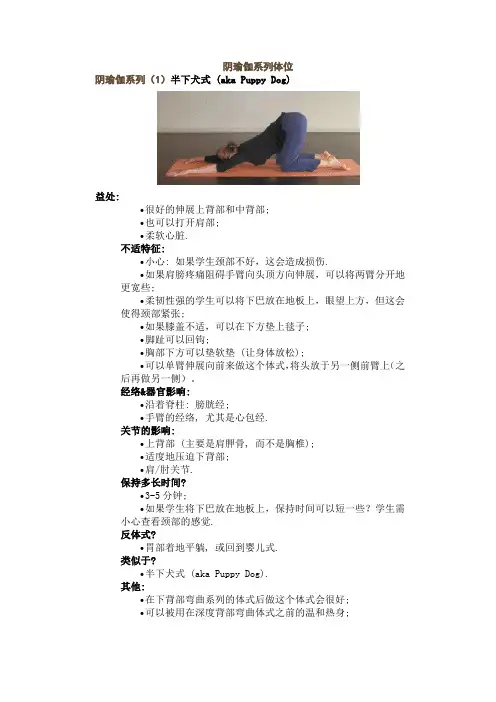
阴瑜伽系列体位阴瑜伽系列(1)半下犬式 (aka Puppy Dog)益处:∙很好的伸展上背部和中背部;∙也可以打开肩部;∙柔软心脏.不适特征:∙小心: 如果学生颈部不好,这会造成损伤.∙如果肩膀疼痛阻碍手臂向头顶方向伸展,可以将两臂分开地更宽些;∙柔韧性强的学生可以将下巴放在地板上,眼望上方,但这会使得颈部紧张;∙如果膝盖不适,可以在下方垫上毯子;∙脚趾可以回钩;∙胸部下方可以垫软垫 (让身体放松);∙可以单臂伸展向前来做这个体式,将头放于另一侧前臂上(之后再做另一侧)。
经络&器官影响:∙沿着脊柱: 膀胱经;∙手臂的经络, 尤其是心包经.关节的影响:∙上背部 (主要是肩胛骨, 而不是胸椎);∙适度地压迫下背部;∙肩/肘关节.保持多长时间?∙3-5分钟;∙如果学生将下巴放在地板上,保持时间可以短一些?学生需小心查看颈部的感觉.反体式?∙胃部着地平躺, 或回到婴儿式.类似于?∙半下犬式 (aka Puppy Dog).其他:∙在下背部弯曲系列的体式后做这个体式会很好;∙可以被用在深度背部弯曲体式之前的温和热身;∙如果学生感到肩部后侧强烈拉伸, 他们可能会有压力?展开手臂 (双手距离加大) 可能会缓解. 如果这种现象的确在这里发生,在下犬和轮式也会出现,因此在这些体式中双手再向两侧打开会更好些.阴瑜伽系列(2)Ankle Stretch脚踝伸展式益处:∙打开和伸展脚踝;∙强烈刺激到四条经过脚踝的经络;∙是蹲坐或脚趾练习很好的反体式.不适特征:∙脚踝有任何尖锐的疼痛,停止练习. 学员可以在脚下垫毯子或毛巾,垫起它们;∙膝盖问题可能会阻碍学员无法坐到脚跟上: 可以拿一块卷起的毛巾, 或其它的垫子, 放在大腿和小腿之间可以缓解这个问题.替代体式:∙双手支地身体后倾是最初的姿势,压力最小, 但是不要弓背,保持挺胸向前;∙片刻之后, 学员可以尝试将双手放在腿的两侧;∙试着不要抬起膝盖,保持胸部打开, 拱背向前;∙最后, 非常柔软的学员可以抬起膝盖,缓慢的收向胸部.对经络&器官的影响:∙胃, 脾脏, 肝脏, 胆囊受到强烈刺激.作用关节:∙脚踝.保持多长时间?∙约1分钟. 这比较偏“阳”,不应保持很长时间.反体式?∙伏地挺身/平板/Chaturanga, 鳄鱼式或任何拉伸腿部和卷压脚趾的体式;∙摇摆或蹲坐也很好。
阴瑜伽体式——龙式及变式详解益处:深度的打开髋部。
能够作⽤到髋关节;也伸展后腿髋部的屈肌和四头肌;许多变式深⼊关节窝打开髋部;对坐⾻神经痛有帮助。
不适迹象:膝盖⾻或脚踝会感觉不舒适。
如果学员⾝体僵硬,让前腿和后腿成90度⾓,重量更多放于膝盖⾻上。
后腿膝盖下垫上毯⼦,或在⼩腿胫⾻下⽅垫上长枕,可以让膝盖离开地⾯。
替代体式:如果后腿膝盖不适,下⽅放上毯⼦,⼩腿下垫上长枕,或脚趾回勾抬后腿离开地板;如果脚踝不适,下⾯垫上毯⼦,或在⼩腿胫⾻下垫上长枕抬⾼膝盖;牢牢的下压脚背,强调⼩脚趾。
(1)婴⼉龙式:⼝令词:双⼿撑于前胸两侧,指尖向前,勾双脚尖,吸⽓,双臂⽤⼒向上推⾼臀部,呼⽓,双肩下压,骶部上推,⾝体下沉,脚跟着地,吸⽓,向后抬⾼右腿,右腿向前跨⾏置于两⼿之间,呼⽓,屈左膝,左膝脚背着地。
在此维持3分钟。
功效:深⼊打开关节窝,打开髋部,缓解坐⾻神经痛,有效的拉伸和刺激到肾经,肝经和肺经及脾经,有效的滋养脚踝和下背部。
(2)⽴飞龙式:⼝令词:吸⽓,抬头,双⼿护右膝,呼⽓,髋部下沉,脊柱后弯,头向后仰,眼睛看向天花板⽅向。
在此维持1-3分钟。
功效:有效的拉伸整条脊柱,及腿部内侧韧带。
刺激到肾经,肝经和肺经及脾经,有效的滋养膀胱经和髋部,脚踝和下背部。
深⼊打开关节窝,打开髋部,缓解坐⾻神经痛,挤压甲状腺和副甲状腺。
(3)侧飞龙式:⼝令词:吸⽓,⾝体回正,呼⽓,松开双⼿,置于右脚内侧,调整呼吸,再次呼⽓,屈双肘,两前臂触地,⽬视前⽅。
感觉轻松的会员,前额或头顶触地。
在此维持1-3分钟。
功效:伸展背部肌⾁群,缓解背部疼痛,预防背部肌⾁僵硬。
伸展脊柱。
拉伸腿部内侧韧带。
刺激到肾经,肝经和肺经及脾经。
有效的滋养脚踝。
深⼊打开关节窝,打开髋部,缓解坐⾻神经痛。
(4)扭转龙式:⼝令词:吸⽓,抬头,保持左臂不动,右⼿扶右膝内侧,呼⽓,右臂⽤⼒将右膝向右侧推⾄⾃⼰的极限,眼睛看向天花板⽅向。
在此维持3分钟。
功效:深⼊打开关节窝,打开髋部,缓解坐⾻神经痛,有效的拉伸和刺激到肾经,肝经和肺经及脾经,有效的滋养脚踝和下背部。
阴瑜伽的好处,练过的人都懂,10个基本体式了解一下就像阴阳理论一样,我们的瑜伽练习也强调对立的力量。
阴阳是瑜伽哲学的中心宗旨,它描述了对立的运动实际上是如何相互补充的。
我们的体式练习通常专注于对立的平衡。
哈他这个词从梵语翻译成太阳(ha)和月亮(tha),这种反作用反映在瑜伽体式中。
诸如Vinyasa或Power Yoga之类的动态练习后可以由诸如恢复性瑜伽或阴瑜伽之类的柔和瑜伽来补充。
阴瑜伽的重点是通过保持恢复性姿势来打开和释放张力,通常需要辅具,以确保各个级别的学生都可以轻松掌握姿势。
以下瑜伽练习中,您将需要:2个瑜伽砖,瑜伽垫,瑜伽毯如果您在家中没有瑜伽辅具,则可以用大枕头或书本。
建议单独进行阴瑜伽练习,或者在进行类似阳性的练习(作为放松)后再进行,因为它可以使身体休息和恢复活力。
以下10个阴瑜伽姿势可在强力瑜伽练习结束后的让你冷静下来:1.有支撑的婴儿式(2个瑜伽砖)好处:刺激放松反应该体式可帮助您从更有活力的练习过渡到更具恢复性的练习。
可以在开始或在摊尸式之前进行练习。
婴儿式有效的放松腰背,还有助于减慢心率并放松身心。
增加辅具可以增强该姿势的恢复性益处,并在准备摊尸式时帮助激活副交感神经系统。
将第一块瑜伽砖以最高高度放在垫子远端第二个块以最低高度放在您面前将支撑垫垂直放在两个瑜伽砖上,为您的身体创造一个斜度张开膝盖,将躯干垂在抱枕上保持姿势两到五分钟2.龙式好处:伸展前腿的髋屈肌先练习几次弓步后再进入此瑜伽姿势,首先以瑜伽砖的最高高度设置支撑,这样您就可以根据强度级别并进行相应的调整。
在垫子前方放置两个瑜伽砖将右脚向前移到瑜伽砖的右侧将左腿伸直,使膝盖和左脚背放在垫子上将手或前臂放在瑜伽砖上,然后将瑜伽砖调整到所需的高度保持姿势两到五分钟,然后在另一侧重复3.鸽子式好处:舒展前腿外侧臀部的臀肌以及后腿的臀部前侧用毯子和垫子支撑您的身体,这样可以使您感到安全,并可以长时间保持。
从四肢着地开始,将右膝盖放于垫子上左腿伸直,使膝盖和左脚背放在垫子上为了增加支撑力,请将折叠的毯子放在右臀部下方为了增加舒适度,请在您的前面放一个支撑垫,并将躯干垂在支撑上保持姿势两到五分钟,然后在另一侧重复4.方块式好处:舒展外臀部在阴瑜伽练习开始时练习该姿势,也可以在瑜伽练习结束时练习。
真人示范阴瑜伽练习全集真人示范阴瑜伽练习全集提示:点上方↑'每天一节瑜珈课'免费订阅哦! '扭转龙式'手向一侧推膝盖并将胸部转向天花板方向;“翼龙式”双手着地膝盖向外摆动几次转动到前脚外侧的极限然后膝盖放低保持可以手肘落地上或手肘落瑜伽砖上“大跨步龙式”锻炼到脚踝,从婴儿龙式开始,让前腿膝盖最大程度向前并/或后脚跟向后滑动,直到脚跟刚要抬离地面(2)立飞龙式:功效:有效的拉伸整条脊柱,及腿部内侧韧带刺激到肾经,肝经和肺经及脾经,有效的滋养膀胱经和髋部,脚踝和下背部深入打开关节窝,打开髋部,缓解坐骨神经痛,挤压甲状腺和副甲状腺(3)侧飞龙式:功效:伸展背部肌肉群,缓解背部疼痛,预防背部肌肉僵硬伸展脊柱拉伸腿部内侧韧带刺激到肾经,肝经和肺经及脾经有效的滋养脚踝深入打开关节窝,打开髋部,缓解坐骨神经痛12、天鹅式:功效:有效的打开髋关节,拉伸腿部,股四头肌,和髋部挤压下背部,有效的刺激生殖系统和泌尿系统,刺激腿部内侧的肝经、肾经和膀胱经13、睡天鹅式:反体式,桥式功效:有效的缓解上一个动作带来的压力,可以温和的打开髋关节,放松髋部,对久坐的人有很好的帮助刺激腿部内侧的肝经、肾经和膀胱经刺激到腿部外侧的胆经14、蜗牛式:功效:有效的拉伸整条脊柱,最大程度的放松整条脊椎,挤压按摩腹腔内的内脏器官,促进髋关节和盆腔区域的血液循环挤压甲状腺和副甲状腺15、快乐婴儿式:功效:深度的打开髋部,当手臂用力的时候,可以强壮肱二头肌,有效的放松骶骨,挤压胃脏,刺激到大腿内侧的肝经,脾经,肾经,肺经和膀胱经对髋部尾骨和骶骨及腰部有很大的溢处16、卧扭转式:功效:放松整条脊柱,肩关节、颈椎和髋关节拉伸腰椎,骨盆,及腹外斜肌;让紧张的系统恢复平衡减轻坐骨神经痛,调节胃脏及胃炎刺激到膀胱经挤压胃部,肋骨刺激胆经,对肝脏,脾脏,和胰脏有很好的帮助滋养胸腔,乳房和肩部周围组织17、婴儿放松式:功效:非常舒适地放松全身的肌肉18、骆驼式:功效:伸展和强壮脊柱;拉伸身体整个前侧及踝关节刺激腹部和颈部器官促进血液循环,增强后侧肌肉滋养脊柱神经强壮生殖系统挤压按摩双肾,激发人体活力纠正驼背和两肩下垂的不良体态19、猫拉尾式:功效:有效的缓解下背部疼痛拉伸腿部前侧的韧带,放松髋关节和底骶骨20、毛毛虫式:功效:有效预防背部肌肉群僵硬柔韧整条脊柱,灵活背部对性腺和生殖系统有很好的帮助缓解生理期的不适挤压按摩心脏,挤压胃部,帮助消化、刺激肾脏21、鞍式:反体式,拍打脚背功效:刺激肝经、胃经、肾经、脾经、肺经及膀胱经强列的打开骸腰肌,伸展臀部区肌和骨四头肌,对经常站立或是运动员有很好的帮助对脊柱和膝盖,踝关节有好处22、悬挂式:功效:温和的伸展下背部,拉伸腿部后侧的韧带,挤压按摩腹腔内脏的器官,减少内脏器官的压力强化横隔膜,调整心率平衡,促进脊神经健康刺激膀胱经,对肝脏,肾脏和脾脏有好处23、蹲式:功效:温和的伸展下背部,拉伸腿部后侧的韧带,挤压按摩腹腔内脏的器官,减少内脏器官的压力强化横隔膜,在生理期时可以缓解疼痛,调整心率平衡,促进脊神经健康刺激膀胱经,对肝脏,肾脏和脾脏有好处加强双踝、双膝、两大腿内侧和子宫肌肌肉24、青蛙式:反体式,拍打脚背功效:深度的打开髋关节,尤其是内收肌,挤压下背部,帮助消化系统和排泄功能,刺激肝经、胃经、肾经、脾经、肺经当手臂前伸时上身的肌肉得到按摩影响心经,胃经、大肠和小肠,对髋关节和下背部都有好处25、大放松式:功效:放松全身补充能量,让身体变得更加健康强壮。
In this section we are going to explore a couple of dozen asanas (an exact count depends upon whether or not one wishes to include variations and options). This selection will suffice to work all the yin areas of the body normally targeted in a yin practice. To learn more about each asana simply click on the name.1.Anahatasana (aka Melting Heart)2.Ankle Stretch3.Butterfly4.Half butterfly5.Camel6.Cat pulling its tail7.Caterpillar8.Child's Pose9.Dangling10.Deer11.Dragons12.Dragonfly (aka Straddle)13.Frog14.Happy Baby15.Lying Twists16.Saddle17.Shavasana18.Shoelace19.Snail20.Sphinx and Seal21.Square22.Squat23.Swan24.Sleeping Swan25.Toe SquatMany students, faced with the challenge of practicing yoga at home, are defeated before they even begin. They feel overwhelmed by the possibilities of what they could do and are not sure how to proceed. Beginning teachers face the same quandary; what do I do to get started well? To reduce the size of this problem it is helpful to think before you even start your practice about your intentions. Once you have your intentions clear in your mind it becomes easy to choose the asanas you will do. We looked at choosing asanas in the previous section. Now let's look at intention.IntentionWhy are you going to do yoga today? You may never have asked yourself this question, and yet you still feel driven to practice. Why?There is no right answer to this question. Anything that brings you to your mat is to be respected. But understanding your inner drive will help you focus on your goal. Reminding yourself of the reason you are doing yoga throughout your practice will help you achieve your purpose. For some students the reason for doing yoga is to gain health. If this is your reason, remind yourself to feel your state of health as you practice, feel the healing energies flowing through you. You will heal faster when you remember this intention.For others the purpose of their practice is to strengthen the body or open it up. Maybe your intention today is to work on opening those stubborn hips. Perhapsin your yang practiceyou have gotten stuckin some pose, and nofurther progress hasbeen coming. Afteryears of effort inprasarita-padottanasana [wide-leggedstanding forwardfold], your head andthe floor are still intwo different timezones. Maybe yourwheel is more like asausage. What may beholding you back is notthe flexibility ofyour muscles -- it maybe that your joints andligaments are tootight. So yourintention today may beto work those areas.Perhaps you are going through a very hectic time in your life right now. You need to slow down. Yin Yoga will provide that balance, and that will become your goal today: balance. Some people do their yoga as part of a meditation practice. Many people do it just because they know they will feel better after they are finished. They like it.These are all perfectly valid reasons for doing yoga. But there can be more: we can set an intention beyond our own benefit. This can be done at the beginning of each practice. Certainly all the other physical, psychological and emotional benefits will still be there but we can achieve even more than that. Prayer for centuries has been used in the same manner; we dedicate our efforts to a greater purpose than ourselves.In the yoga texts this is called ishvara-pranidhana--a surrendering of your efforts to something greater than yourself. As you sit or stand at the beginning of your practice, bring to mind someone or something that needs special assistance, attention or gratitude. Dedicate your efforts during your practice to that person or thing. This dedication fills you with a resolve to actually do the practice with full attention along with the intention. As you practice remind yourself why you are practicing.When a challenging time comes up in the practice (and it usually will), you will find the extra strength you need because of your dedication. Higher intentions allow the fruits of your practice to go beyond yourself. Paradoxically, this makes you even stronger, but that is not the point.1.Anahatasana(Melting Heart)Benefits:•Good stretch for the upper and middle back;•Will also open shoulders;•Softens the heart.Contra-indications:•Be careful: if student has a bad neck as this could strain it. Alternatives & Options:•If shoulder pain prevents the arms going over head, move arms wider apart;•Flexible students can bring chin to floor and look ahead, but this could strain the neck;•If knees are uncomfortable here, place a blanket underneath them;•Toes can be tucked under;•Chest can be rested on a bolster (allowing the body to relax). Meridians & Organs Affected:•Along the spine: Urinary Bladder lines;•The arm meridians, especially the Heart and Lung lines.Joints Affected:•Upper back (which is actually the scapula not the thoracic spine);•Mildly stresses the lower spine;•Shoulder/Humerus joint.Hold for how long?•Three to five minutes;•If the student is resting chin on floor, the hold may need to be shorter ?they have to watch the sensations in their neck carefully. Counter poses?•Lying on stomach, or go back to Child's Pose.Similar to?•Half Down Dog (aka Puppy Dog).Other Notes:•It is nice to do this pose after a series of lower back bends;•Could be used as a gentle warm up to deeper back bends;•If students feel pinching in the back of the shoulders, they may be reaching a compression point ?abducting the arms may releasethis. If this does happen here, it probably happens in Down Dog and the Wheel too, so they may be well advised to have hands wider in these poses.2.2. Ankle StretchBenefits:•Opens and strengthens the ankles;•Strong stimulation of four meridians flowing through the feet and ankles;•Great counter pose for squatting or toe exercises.Contra-indications:•Any sharp pain in ankles, back off. Students can try a blanket or towel under the feet to cushion them;•Knee issues may prevent the student from sitting on heels: placinga towel between the thighs and calves may reduce this. Alternatives & Options:•Leaning back on hands is first position, and is the least stressful, but beware of students collapsing backwards ?keep heart forward;•After a few moments, the student can try to bring hands to the floor beside the legs;•Try not to lean away from the knees ?keep the heart open;•Finally, the very open student can hold the knees and gently pull the knees towards the chest.Meridians & Organs Affected:•Stomach, Spleen, Liver, Gall Bladder lines are strongly stimulated. Joints Affected:•The ankle.Hold for how long?•About one minute. This is relatively yang and shouldn't be held fora long time.Counter poses?•Pushup/Plank/Chaturanga, Crocodile or any posture that straightens the legs and tucks the toes under;•Dangling or Squatting is also nice.Other Notes:•This is a nice counter pose for many poses that stress the feet, such as sitting on heels with toes tucked under, Squats, and sitting meditations3.3.ButterflyBenefits:•Nice way to stretch lower back without requiring loose hamstrings;•If the legs are straighter and the feet are further away from the groins, the hamstrings will get more of a stretch. If the feet are in closer to the groin, the adductor muscles get stretched more,but this is less yin like;•Iyengar claims this removes "heaviness in the testicles and is a boon to women ? to regulate periods, ovaries function properly and make delivery easier ?.Contra-indications:•Seated forward bends are the hardest for the pelvis and knees. They can aggravate sciatica. If a student has this condition, elevate the hips so knees are below the hips. Beware of hips rotatingbackwards while seated. We want the hips to rotate forward;•Ok for pregnant women as the legs are abducted providing space for the belly;•Avoid if the neck has suffered whiplash or has reverse curvature. Alternatives & Options:•Elevate the hips with a bolster or cushion;•If neck is tired support head in hands, resting elbows on knees or thighs;•Could rest chest on a bolster;•Various hand/arm positions are possible: hold feet, hands on floor in front of student, or arms relaxed behind the body;•Can do this lying down keeping legs in butterfly.Meridians & Organs Affected:•The Gall Bladder line on the lower leg as well as the Urinary Bladder lines running along the spine in the lower back [These are the same as the ida and pingala nadis];•Iyengar highly recommends this pose for people suffering urinary problems;•Iyengar also says this is good for kidneys and prostrate gland. Joints Affected:•Hips and lower spine;Hold for how long?•Three to five minutes;•Can hold much longer, if desired ?or you may do this while reading, or talking on phone?Counter poses?•Sitting up or a gentle sitting back bend;•Lying on stomach is also a gentle back bend;•Could do a spinal lift flow on the back or flow into Tabletop [aka Hammock]. Tabletop is done by sitting on the floors with knees bent, hands behind you, and pressing feet and hands into the floor, then lifting the hips as high as possible. This can be a flow by lifting and lowering the pelvis several times slowly, with each breath, before holding the highest position for a few breaths;• A seated twist.Similar to?•Baddha Konasana, but without the emphasis on a straight spine or the feet in tight to groins. Here we want the back to round, allowing the head to drop to the heels.Other Notes:•Can be done after meals, as long as head does not touch the floor (which would be too much pressure in the abdomen);•If the feet are closer in, tight adductors or lower back tightness may prevent student from folding forward. Move the feet further away;•Many students will automatically go into a tight butterfly, because of their yang training ? encourage them to move feet away, forminga diamond shape with the legs.4.4.Half ButterflyBenefits:•Nice way to stretch lower back, without requiring loose hamstrings;•The ligaments along the back of the spine are specifically targeted;•Iyengar claims this stimulates the liver and kidneys and aids digestion (when folding over the straight leg).Contra-indications:•Can aggravate sciatica: if so, elevate hips until the knees are below the hips. Beware of hips rotating backwards while seated: we want the hips to rotate forward;•Ok for pregnant women, because the legs are abducted, providing space for the belly;•Beware of any sharp pain in knees ?if knees issues are present, tighten the top of the thigh (quadricep), which will close thejoint, or reduce the angle between the legs;•If the bent knee complains, place support under it, or move that foot away from groin;•If the hamstrings protest, bend the straight knee and support the thigh with a blanket, or block, under it.Alternatives & Options:•Can fold over straight leg, which maystretch hamstring much more. See toppicture;•Reach opposite arm to extended footand/or lower that shoulder toemphasize the side of the spine;•Add a twist to the spine by placingarm along side the straight leg andthe other arm behind the back, or overthe head, and rotate the chesttowards the sky. This deepens theemphasis along the side of the ribsand spine. See middle picture;•Place the bent knee foot in Virasana(folded backwards behind thebuttock), but only if knee doesn'tcomplain. See bottom picture.Meridians & Organs Affected:•Urinary Bladder;•If there is a lot of sensation in thegroin, the spleen, liver and kidneysare stimulated.Joints Affected :•Spine, especially the back and sides;•Knees, although this is not as deepan opener for the knees as Dragonfly[aka Straddle].Hold for how long?•This can be held a long time about five minutes, with the variations added after about three minutes.Counter poses?•Sitting up or a gentle sitting back bend;•Flow into Tabletop (aka Hammock). Tabletop is done by sitting on the floors with knees bent, hands behind you, and pressing feet and hands into the floor, then lifting the hips as high as possible.This can be a flow by lifting and lower the pelvis several times slowly, with each breath, before holding the highest position fora few breaths;•Windshield Wipers [lowering knees side to side] while resting on hands or elbows.Similar to?•Janusirsasana, but here we aren't trying to bring the head to the foot; rather, we are bringing the head to the knee. Allow the back to round;•Paul Grilley calls the variation with the foot in Virasana the Half Frog5.CamelBenefits:•Like Saddle pose, the Camel deeply arches the sacral/lumbar arch and opens the top of the thighs. There is less opening in the ankles than the Saddle, but there is still some opening there;•Stretches hips flexors and opens the shoulders - Iyengar says this is excellent for people with drooping shoulders or hunched backs. Contra-indications:•Iyengar claims that the elderly, or people with spinal injuries, can do this pose. However, to be sure this is safe, seek medical advice if you fit either category;•Without support the back can spasm, so people with weak backs may want to do only the gentle versions (see below);•If you have any neck issues, do not drop head back - keep chin to chest.Alternatives & Options:•There are two ways to go into this pose: by holding hands on thehips and pushing the hips forwardas you arch back, or by having thehands on the floor behind you andwalking the hands forward (asshown below), until you havereached an edge;•Dropping back may be unsuitable for people with back problems,because there is little supportfrom the hands in this version:do the hands on the floor versioninstead;•Walking the hands on the floor towards the feet may beunsuitable for people with kneeproblems, because there is morepressure in the knees in theearly stages of this variation;•Very flexible students may wish to bring their hands to the floorbetween the feet, or move thehands towards the knees;•For less flexible students, the toes can be tucked under and thehands rested on the heels, or ona block between the feet. Meridians & Organs Affected:•Urinary Bladder, Kidney andStomach meridians;•Thyroid is stimulated if the neck is dropped back.Joints Affected:•The spine, shoulders and ankles.Hold for how long?•One to two minutes at most. [This is a very yang-like pose and requires a lot of leg strength in the full pose, or if your hands are on your hips or lower back. In the supported pose, with the hands on the floor, or on your legs, or feet, you may stay longer as you can rest on your arms.]Counter poses?•Child's Pose ?Coming out slowly, lift chest forward allowing the head to remain dropped back, until the shoulders are over the hips;then bring the head forward and sit back into Child's Pose. Similar to?•Ustrasana (ustra means camel).6.Cat Pulling Its TailBenefits:•This back bending twist is useful as a nice counter pose to strong forward bends (such as the Snail);•Decompresses the lower back;•Opens the quadriceps and upper thighs.Contra-indications:•If student has lower back issues this can still be performed, but go gently. Most students, in this case, will not be able to pull the foot away at all.Alternatives & Options:•Easiest version is to be proppedup on one arm, as shown;•The more challenging version is torecline, and look over shoulder tothe foot. In this version it is areclining twist with a backbend.Emphasize pulling the foot awayfrom the buttock. Most studentswill not be able to do this.Meridians & Organs Affected:•Stimulates the Stomach meridian(if the top of the thigh isactivated) and the UrinaryBladder line (when the back isarched and twisted).Joints Affected:•Mostly opens the lumbar/sacrum.Hold for how long?•One minute, if doing as a counterpose to a forward bend;•Can hold longer as a reclining twist: three to five minutes. Counter poses?•Hug knees to chest to release lower back in a gentle forward fold.Do this either while lying on the back or in Child's Pose.Similar to?•Jatharaparivartanasana, with a back bend.Other Notes:•If the student is actively pulling the foot away, the pose becomes yang-like in nature. In this case, she may shorten the time, or she should release the pressure after one minute7.CaterpillarBenefits:•Stresses the ligaments along the back of the spine;•Compresses the stomach organs, which helps strengthen the organs of digestion;•Stimulates the kidneys;•Iyengar claims this pose helps to cure impotency and leads to sex control. Also, since the heart is below the spine, the heart is massaged.Contra-indications:•Students with sciatica should raise their hips by sitting on a bolster;•If hamstrings are very tight the knees should be bent and supported by a bolster allowing the spine to round.Alternatives & Options:•Bend knees, and support them with a bolster, to allow the back to round fully;•If neck feels strained by the weight of the head, students can support their heads in their hands, resting their elbows on the legs or a bolster;•The student could rest chest on a bolster to help relax into the pose;•Can also rest the legs up the wall [bend the knees and allow the feet to be flat against the wall];•If knees are strained, or weak, activate the quadriceps (but not all the time!).Meridians & Organs Affected:•The Urinary Bladder.Joints Affected:•The spine.Hold for how long?•Three to five minutes or more.Counter poses?•Sitting up or a gentle sitting back bend;•Lying on the stomach is a gentle back bend, as is doing a spinal lift flow on the back, or flow into Tabletop (aka Hammock). Tabletop is done by sitting on the floors with knees bent, hands behind you, and pressing feet and hands into the floor, then lifting the hips as high as possible. This can be a flow by lifting and lowering the pelvis several times slowly, with each breath, before holding the highest position for a few breaths ...;• A seated twist.Similar to?•Paschimottanasana, but here we are not trying to lengthen the spine,or stretch the back muscles. Don't try to bring the head to the feet, but rather round the spine so the head comes to the knees.Other Notes:•Paul Grilley claims this pose is excellent for balancing Chi flow, and preparing the body for meditation;•Keep muscles relaxed especially in the legs;•Make sure the tops of the student's hips are tilted forward ?if the student's hips are rotating backwards, have her sit on highercushions and bend the knees more.8.Child's PoseBenefits:• A healing, restful pose - useful any time a break is needed;•Gently stretches the spine: this is always a nice counter pose for backbends;•Gentle compression of the stomach and chest is beneficial for the organs of digestion;•Psychologically soothing when feeling cold or vulnerable;•Can relieve back and neck pain when the head is supported;•Rocking gently side to side can help stimulate the flow of blood and lymph fluids in the chest.Contra-indications:•Diarrhea or pregnancy;•Just after eating, this can be uncomfortable;•If knee issues exist, the student may need to place towel or blanketbetween thighs and calves, or avoid the pose altogether;•While this is a gentle opener of the ankles, the student may need blanket under her ankles to reduce discomfort on the top of the feet.Alternatives & Options:•Could be done with arms stretched forward;•Some students cannot get buttocks to heels, which means the head will have a lot of weight on it. They should support the neck by placing the forehead on their hands or on a bolster;•Can do this as preparation for the Frog by spreading the knees apart halfway through the pose, but remain sitting on heels;•Allow knees to be as wide apart as is comfortable;• A blanket or towel can be rolled up and placed under the ankles to reduce stress on the top of the feet.Meridians & Organs Affected:•The Stomach, Kidneys and Urinary Bladder.Joints Affected:•The spine and ankle.Hold for how long?•As long as the student wants;•Used as a counter pose, usually hold up to one minute;•Used as a yin pose on its own, hold for three to five minutes.However, if student cannot get her head to the floor, five minutes may be too long here.Counter poses?• A counter pose not normally needed after this pose. Students could go directly to any other poses.Similar to?•Balasana or GarbhasanaOther Notes:•In Yin Yoga, this pose could be used as a preparation for Dragonfly pose, or for deeper forward bends like Snail9.DanglingBenefits:•Gentle stretch for the lower spine;•Warms up the hamstrings and leg muscles;•Compresses the stomach and internal organs;•Diaphragmatic breathing is harder while in this posture: this pose builds strength in the diaphragm, while providing a massage for the abdominal organs;•Cures stomach pain during menstruation;•Heart rate is slowed and spinal nerves rejuvenated.Contra-indications:•Avoid if student has high blood pressure [this pose will increase BP];•If student has low blood pressure, she should roll up to standing slowly, or go into squat;•If someone has a bad back, she must bend her knees a lot! She canalso rest her elbows on her thighs.Alternatives & Options:•Bend knees more … this will strengthen the legs and release the back;•Rest elbows against a table or chair, if the back feels strained;•Caterpillar is an easier alternative;•Really flexible students can hold wrists behind the legs, but we still want back rounded in this yin posture.Meridians & Organs Affected:•Due to the intense stretch along the back of the legs and spine, the Urinary Bladder meridian is highly stimulated;•Iyengar says this is great for the liver, spleen and kidneys. Joints Affected:•The Spine.Hold for how long?•Three minutes can be pretty intense: often this pose is done in two, or more sessions, of two minutes each, separated by Squat. Counter poses?•Squat, or gentle back bend [Cat, lying on stomach, sitting forward arch…].Similar to?•Uttanasana, but the emphasis here is not to stretch the hamstringsa lot, but rather to release the lower back. If the legs arestraight, it is a nice stretch for the hamstrings, but there islittle muscular effort needed. If the knees are bent, it is a great strengthener for the leg muscles and allows the back to release morefully.Other Notes:•Ensure the arches of the feet are lifting;•Balance the weight between toes and heels … could gently sway or wobble;•Straight legs will stretch hamstrings;•Bent knees will strengthen thigh muscles;•Better to bend knees and receive a stomach massage too;•Can intermix this and Squat: eventually hold both for four minutes, or more, in total.10.DeerBenefits:• A nice counter pose to hip openers or any external rotation of the hips;• A balanced way to rotate hips, both externally (front leg) and internally (back leg);•Improves digestion and relieves gas;•Helps to relieve the symptoms of menopause;•Reduces swelling of the legs during pregnancy (until the end of the second trimester);•Therapeutic for high blood pressure and asthma.Contra-indications:•If any knee issues exist, be careful of externally rotating hip (front knee). Keep foot in closer to groin. Could support the front knee with a bolster, or blanket, under the knee.Alternatives & Options:•The tendency here is to tilt to the internally rotating hip of the back leg. Make sure sitting bones are firmly on the floor. This may require moving the feet more towards the core of the body;•Very flexible students can begin to move their feet away from their hips.Meridians & Organs Affected:•If the legs are firmly on the floor, the Gall Bladder line is activated. Any inner groin sensations indicate that the Spleen, Liver and Kidneys are benefiting.Joints Affected:•Hips.Hold for how long?•Most students can't do this pose well enough to get a lot of benefit from it. So, it is useful mostly as a counter pose. As a counter pose, just hold for up to one minute.Counter poses?•Since this pose is both an external and internal hip rotation, the best counter pose is to do the other side;•Windshield Wipers are nice: they can be done lying down, sitting up, or reclining on elbows.Similar to?•This is a combination of Virasana (hero pose) and Padmasana (lotus)pose.Other Notes:•Useful after long held, external hip rotations such as Shoelace, Swan or Dragonfly, where both legs were wide apart •Most students won't easily understand what the pose is about ?they won't move their feet far enough away from the groin or hips, or they will tilt too much. The teacher will have to inspect their efforts and offer guidance.11.DragonsBenefits:•Deep hip and groinopener … gets right intothe joint;•Also stretches the backleg's hip flexors andquadriceps;•Many variations to helpwork deeply into hipsocket;•Can help with sciatica.Contra-indications:•Can be uncomfortable forthe kneecap or the ankle.If the student is stiff,the back thigh will be atninety degree angle to thefront thigh, putting a lotof weight on the kneecap.Support the back knee withblanket under it, or placebolster under shinallowing the back knee tobe off the floor. Options:•If back knee isuncomfortable, placeblanket under it, rest theshin on a bolster, or tuckthe toes under and lift theleg off the floor. [Liftingthe back leg off the flooris much more advanced];•If ankle is uncomfortable, place blanket underneathit, or raise knee byputting bolster under theshin;•Press top of foot downfirmly, emphasizing thelittle toe.Alternative Dragons:1.The first option is asimple low lunge called the"Baby Dragon"2.The next option is to restarms or hands on frontthigh, and lift the chestto increase the weight overhips. This is the "DragonFlying High";3. A deeper option is to placeboth hands inside frontfoot (ensuring the footdoesn't slide inwardtowards a Pigeon position)in "Dragon Flying Low", andwalk hands forwardloweringhips. Could comedown on elbows, or restelbows on to a bolster orblock;4.Twisted Dragon - one handpushes front knee to theside while rotating thechest to the sky;5.Winged Dragon: With handson floor, wing out the kneea few times, rolling ontothe outside of that foot,and then stay with the kneelow. Could come downon elbows or rest elbows ona block or bolster;6.Overstepping Dragon:exercises the ankle. FromBaby Dragon, allow thefront knee to come farforward and/or slide heelbackwards, until the heelis just about to lift offthe ground;7.Dragon Splits: the deepeststretch for hip flexors.Straighten both legs in thesplits. Students cansupport the front hip witha bolster under the buttockfor balance and to releaseweight, which relaxes themuscles. Student can sit uptall or fold forward fordifferent stretches;8.Fire Breathing Dragon: inany of the abovevariations, tuck the backtoe under and lift the kneeup, lengthening the leg.This puts more weight intothe hips, increasing thestretch.Meridians & Organs Affected:。
文章导读
瑜伽是现在很多女性朋友的新宠,瑜伽可以活动身体,能够消除疲劳,还可以拉伸肌肉,减肥和美容效果都是很好的,而且大家不用担心的是,没有副作用,鉴于瑜伽有这么多好处,所以很受大家的欢迎。
瑜伽有很多种类型,阴瑜伽是一种阴柔的瑜伽种类,每一种瑜伽对人的作用都不太一样。
现在就来和大家介绍一下阴瑜伽体式有哪些。
常见阴瑜伽体式:
1、脚踝伸展式
经络和器官影响:强烈刺激胃、脾脏、肝脏、胆囊。
2 、蝴蝶式
经络和器官的影响:腿外侧的胆经和通过下背部影响到贯穿脊柱的膀胱经。
如果双脚向内靠近腹股沟会感到大腿内侧的伸展,肾经和肝经受到刺激。
3 、半蝴蝶式
经络和器官影响:足太阳膀胱经,肝经,脾经。
如果在腹股沟和腿内侧感受强烈,肝脏和肾脏会受到刺激。
4、鞋匠式
经络和器官影响:肝和脾,因为这些经络通过内腹股沟,外加腿外侧的胆囊。
如果折叠前屈,膀胱经受到刺激,胃也得到压力。
文章导读
5 、婴儿式
经络和器官影响:脾脏、胃、肾经和膀胱经。
6、猫拉尾式
经络和器官影响:刺激胃经、脾经(如果大腿前侧受到拉伸)和膀胱经、肾经(当背部前拱和扭转时)。
7、骆驼式
经络和器官影响:膀胱经,肾经和胃经。
如果没有先天厚赠,那就太需要后天的弥补了;否则,人过中年便注定要每况愈下,衰老之势态不可挡。
身体需要运动,经络更需要锻炼,经络是修复身体器官损伤的无形触手的忠实保镖。
阴瑜伽可以很好地拉伸经络,不同的体式针对不同的经络。
今天推荐一套阴瑜伽体式,专门拉伸肾经。
1.仰卧束角∙躺在瑜伽抱枕上,双手打开掌心朝上∙∙双脚掌相对,膝盖下沉,膝盖下方垫个瑜伽砖(如果膝盖太高)∙∙保持3分钟∙然后双手十指交扣上举来到头顶,保持1分钟2.束角式脚掌相对,抱枕放在膝盖中间趴在抱枕上,保持3分钟也可以额头放在砖块上,手掌心向上,保持3分钟3.坐角式双脚打开到最大角度,脚回勾,背部立直,保持1分钟把身体转向右侧,背部立直,保持1分钟弯曲右膝盖,保持1分钟双腿打开,往右侧折叠,额头放在砖块上,保持1分钟∙弯曲右膝盖,继续额头放在砖块上∙换边重复以上体式身体往前方折叠,趴在抱枕上,保持3分钟4.英雄坐卧从金刚坐开始,膝盖并拢,臀部坐脚跟,背部立直,保持1分钟英雄坐,膝盖并拢,脚分开,臀部坐地面卧英雄,躺在抱枕上,保持3分钟也可以直接躺在瑜伽垫上5.龙式右脚踩地,左膝盖着地,双手在双脚两侧,脊柱延展,保持1分钟,换边重复6.神猴式左脚踩地,右膝盖着地,双手在双脚两侧,脊柱延展,保持1分钟,换边重复∙半神猴式,右膝盖着地,对齐右膝盖∙∙左腿伸直,脚回勾∙∙右腿向后伸直,髋部摆正,砖块在左臀部下方,保持3分钟∙∙换边重复∙7.婴儿式脚并拢,膝盖稍微打开,手在身体两侧,保持3分钟8.下犬式双脚打开与髋同宽,来到下犬式,保持1分钟9.坐立前屈先来到坐山式,脚回勾,保持1分钟抱枕放在腿上方,身体往前折叠,保持3分钟10.快乐婴儿式仰卧,弯曲膝盖,双手抓脚底,膝盖分开,膝盖找地面,保持3分钟11.单脚锁腿+扭转仰卧,弯曲右膝盖,双手拉膝盖靠近胸腔,保持1分钟右膝盖倒向左侧,肩膀保持压地,保持1分钟12.倒箭式双腿放在墙上,双手打开,保持5-10分钟。
阴瑜伽 25大体式及变式详解:一、古典拜日式热身二、调息冥想三、体位法练习四、休息放松术注意事项:1、一节课内不能同时出现方形式和鞋带式。
2、悬挂式与蹲式不能分开做,必须接在拜日式后面做。
3、脊柱后弯类动作保持的时间5个呼吸就可以了。
2、脚踝伸展式:口令词:屈双膝,臀部坐于两脚跟上,呈金刚坐姿坐好,双手至体侧撑地,吸气,抬起双膝离开垫面,双手摊放在双膝上,腰背挺直,目视前方。
注意:臀部尽量坐于两脚心上。
感觉困难的会员可将双手体侧撑地。
在此维持1-3分钟。
呼气,双手体前撑地,双膝落于垫子上,快速拍打脚背放松,抬起双小腿,轻轻旋转脚踝放松。
功效:有效伸展脚踝,刺激到经过脚踝的四条经络,胃、脾、肝和胆这四条经络;灵活踝关节,增强踝关节的承受能力。
3、全蝴蝶式:口令词:屈双膝,脚心相对,双手十指相扣抓住双脚尖,仰头吸气,呼气,身向前倾,前额触碰双脚尖。
注意:腹部内收,腰背拱起。
在此维持3-5分钟。
吸气,头部带动身体缓缓直立。
呼气,松开双手,两腿前伸,抖动,放松。
功效:伸展脊柱及下背部,拉伸腿部内侧韧带;有效的刺激肾上腺体及卵巢,还可以刺激经过腿部内侧的肝经、脾经和肾经及下背部的膀胱经;对泌尿系统有很好的帮助,调整女性生理期的不正常,促进髋关节和盆腔的血液循环。
主要对胯部和下背部的帮助。
减轻妇女分勉痛苦。
4、半蝴蝶式:反体式,对侧练习口令词:直角坐姿,屈左膝,左脚跟抵住会阴穴,右脚向右侧展开,双手体前撑地,吸气,抬头,呼气,身向前倾,眼睛看向肚脐方向。
注意:腹部内收,腰背拱起。
在此维持3-5分钟。
吸气,头部带动身体缓缓直立,呼气,全身放松。
功效:可以很好的伸展下背部的肌肉群;刺激肝脏、脾经、肾脏及膀胱经;帮助消化、帮助泌尿系统以及经过腿部内侧的肝经、脾经和肾经;还可以拉伸腿部内侧韧带,拉伸整条脊柱和背部,尤其是针对后背部的韧带;半蝴蝶变式(1):口令词:右手护左腰,吸气,抬起左臂贴近左耳,呼气,身向前倾,左手抓住右脚尖,扭转头部,眼睛看向天花板方向。
注意:每次呼气时,将身体下沉,尽量贴近右腿。
在此维持1-3分钟。
吸气,左臂带动身体缓缓直立,呼气左臂至体侧飘落,松开右手。
功效:可以很好的刺激肝脏、脾经、肾脏及膀胱经;帮助消化、帮助泌尿系统以及经过腿部内侧的肝经、脾经和肾经;还可以拉伸腿部内侧韧带及侧腰韧带;消除侧腰的脂肪。
半蝴蝶变式(2):口令词:身向右转,吸气,双臂至体侧高举过头,两臂夹耳,呼气,身向前倾,双手抓住右脚踝,吸气,抬头,呼气,身体下沉,尽量贴近右腿,在此维持1-3分钟。
松开双手,吸气,双臂带动身体缓缓直立,呼气,双臂至体侧飘落,身体转向正前方,慢慢伸直左膝,做对侧练习。
功效:可以很好的伸展整个背部的肌肉群;刺激肝脏、脾经、肾脏及膀胱经;帮助消化、帮助泌尿系统;还可以拉伸腿部内侧韧带,拉伸整条脊柱和背部,放松髋关节。
半蝴蝶变式(3):口令词:直角坐姿,屈左膝,左小腿置于臀部左侧,右脚向右侧展开。
身向右转,吸气,双臂至体侧高举过头,两臂夹耳,呼气,身向前倾,双手抓住右脚尖,扭转头部,眼睛看向天花板方向。
注意:每次呼气时,将身体下沉,尽量贴近右腿。
在此维持1-3分钟。
吸气,双臂带动身体缓缓直立,呼气,双臂至体侧飘落,松开双手。
两腿前伸,抖动,放松。
功效:可以很好的刺激肝脏、脾经、肾脏及膀胱经;帮助消化、帮助泌尿系统以及经过腿部内侧的肝经、脾经和肾经;还可以拉伸腿部内侧韧带及侧腰韧带;消除侧腰的多余脂肪。
有助于缓解膝关节疼痛。
5、骆驼式口令词:在婴儿式放松的基础上,吸气,抬头,身体跪立,呼气,双膝分开,与肩同宽,身向右倾,右手抓住右脚踝,身向左倾,左手抓住左脚踝,呼气,髋部前推,脊柱后弯,头向后仰,在此维持3分钟。
注意:双大腿保持与地面垂直。
松开左手,吸气,左臂带动身体缓缓直立。
松开右手,呼,双膝双脚并拢,前额触地,全身放松。
功效:伸展和强壮脊柱;拉伸身体整个前侧,及踝关节。
刺激腹部和颈部器官促进血液循环,增强后侧肌肉。
滋养脊柱神经。
强壮生殖系统。
挤压按摩双肾,激发人体活力。
纠正驼背和两肩下垂的不良体态。
6、猫拉尾式:口令词:右侧卧在垫子上,右肘撑地,调整身体在一条直线上,屈右膝,左手抓住右脚踝,将右脚跟拉向臀部,眼睛看向天花板方向。
注意:左膝伸直。
在此维持3分钟。
松开右手,伸直右膝,做对侧练习。
功效:有效的缓解下背部疼痛。
拉伸腿部前侧的韧带,放松髋关节和底骶骨。
猫拉尾变式:口令词:右侧卧在垫子上,右肘撑地,调整身体在一条直线上,屈右膝,左手抓住右脚踝,将右脚跟拉向臀部,扭转上半身,背部贴地,眼睛看向天花板方向。
注意:左膝伸直。
在此维持3分钟。
松开右手,伸直右膝,做对侧练习。
功效:有效的缓解下背部疼痛。
柔韧整条脊柱。
拉伸腿部前侧的韧带,放松髋关节底骶骨。
6、猫伸展式:口令词:双手体前撑地,双膝脚背着地,吸气,向上推高臀部,呼气,屈肘,两臂前伸,下巴,胸部贴地,注意:大腿与地面垂直。
在此维持3分钟。
将右耳枕于右臂上,吸气,抬起左臂指向天花板方向,呼气,左臂绕过体后抓住右大腿根部,眼睛看向天花板方向,注意:每次呼气时,左臂尽量向后侧展开,在此维持1-3分钟。
松开双手,吸气,左臂还原指向天花板方向,呼气,放下左臂,将左耳枕于左上臂上,做对侧练习。
呼气,放下右臂。
功效:伸展上背部和中背部,打开肩关节,滋养心脏,滋养脊柱,刺激膀胱,以及手臂上的经络,尤其是心包经,刺激肩甲骨的肌肉群,缓解肩背部的疼痛。
7、毛毛虫式:口令词:直角坐姿,坐于垫子上,吸气,双臂至体侧高举过头,两臂夹耳,呼气,身向前倾。
注意:腹部内收,眼睛看向肚脐方向。
吸气,双臂带动身体直立。
配合呼吸,反复练习3次。
最后一次维持3分钟。
两臂夹耳,吸气,双臂带动身体缓缓直立。
呼气,双臂至体侧飘落,全身放松。
功效:有效预防背部肌肉群僵硬。
柔韧整条脊柱,灵活背部。
对性腺和生殖系统有很好的帮助。
缓解生理期的不适。
挤压按摩心脏,挤压胃部,帮助消化。
刺激胜脏。
9、悬挂式:口令词:站立在垫子上,吸气,抬起双臂贴双耳,屈双肘,双手环抱双肘,呼气身向前倾,注意:腹部内收,腰背拱起,眼睛看向肚脐方向。
在此维持3分钟。
吸气,双臂带动身体缓缓直立。
呼气,松开双手,放下双避孕,全身放松。
功效:背温和的伸展下背部,拉伸腿部后侧的韧带,挤压按摩腹腔内脏的器官,减少内脏器官的压力。
强化横隔膜,在生理期时可以缓解胃病,调整心率平衡,促进脊神经健康。
刺激膀胱经,对肝脏,肾脏和脾脏有好处。
10、鹿式:反体式,对侧练习口令词:直角坐姿,屈右膝,将右脚跟抵住会阴穴,屈左膝,左脚置于臀部外侧,双手体前撑地,仰头吸气,呼气,身向前倾,前额触地,注意:腹部内收,腰背拱起,眼睛看各肚脐方向。
在此维持3分钟。
吸气,头部带动身体缓缓直立,呼气,身向左后方扭转,左手体后撑地,扭转头部,眼睛看向左后方。
在此维持3分钟。
吸气,头部带动身体还原向前。
呼气,全身放松,左手摊放在身体左侧,吸气,抬起右臂贴近右耳,呼气,身向左倾,眼睛看向天花板方向。
在此维持3分钟。
吸气,右臂带动身体缓缓直立,呼气,右臂至体侧飘落,两腿前伸,做对侧练习。
功效:有效的打开髋关节和胯部,改善消化系统,预防与治疗胃胀气。
对更年期的女性有很好的帮助。
怀孕6个月以前的的孕妇练习可消除腿部胀气。
对高血压和哮喘有好处。
刺激胆经、肝经、胃经、肾经、脾经、肺经。
11、龙式及变式:(1)婴儿龙式:口令词:双手撑于前胸两侧,指尖向前,勾双脚尖,吸气,双臂用力向上推高臀部,呼气,双肩下压,骶部上推,身体下沉,脚跟着地,吸气,向后抬高右腿,右腿向前跨行置于两手之间,呼气,屈左膝,左膝脚背着地。
在此维持3分钟。
功效:深入打开关节窝,打开髋部,缓解坐骨神经痛,有效的拉伸和刺激到肾经,肝经和肺经及脾经,有效的滋养脚踝和下背部。
(2)立飞龙式:口令词:吸气,抬头,双手护右膝,呼气,髋部下沉,脊柱后弯,头向后仰,眼睛看向天花板方向。
在此维持1-3分钟。
功效:有效的拉伸整条脊柱,及腿部内侧韧带。
刺激到肾经,肝经和肺经及脾经,有效的滋养膀胱经和髋部,脚踝和下背部。
深入打开关节窝,打开髋部,缓解坐骨神经痛,挤压甲状腺和副甲状腺。
(3)侧飞龙式:口令词:吸气,身体回正,呼气,松开双手,置于右脚内侧,调整呼吸,再次呼气,屈双肘,两前臂触地,目视前方。
感觉轻松的会员,前额或头顶触地。
在此维持1-3分钟。
功效:伸展背部肌肉群,缓解背部疼痛,预防背部肌肉僵硬。
伸展脊柱。
拉伸腿部内侧韧带。
刺激到肾经,肝经和肺经及脾经。
有效的滋养脚踝。
深入打开关节窝,打开髋部,缓解坐骨神经痛。
(4)扭转龙式:口令词:吸气,抬头,保持左臂不动,右手扶右膝内侧,呼气,右臂用力将右膝向右侧推至自己的极限,眼睛看向天花板方向。
在此维持3分钟。
功效:深入打开关节窝,打开髋部,缓解坐骨神经痛,有效的拉伸和刺激到肾经,肝经和肺经及脾经,有效的滋养脚踝和下背部。
拉伸腿部内侧韧带。
挤压甲状腺和副甲状腺。
扩展胸腔。
(5)翼龙式:口令词:松开右手,置于右脚内侧,保持右膝不动,呼气,屈肘,身体下沉,头顶触地。
在此维持3分钟。
功效:深入打开关节窝,打开髋部,缓解坐骨神经痛,有效的拉伸和刺激到肾经,肝经和肺经及脾经,有效的滋养脚踝和下背部。
拉伸腿部内侧韧带。
放松整条脊柱。
(6)大跨步龙式:口令词:吸气,抬头,右脚掌踩地,双手撑于右脚两侧,呼气,髋部下沉,右脚向前推至自己的极限,尽量做到竖叉的姿势。
吸气,双臂至体侧高举过头,两臂夹耳,呼气,脊柱后弯,头向后仰,眼睛看向天花板方向。
在此维持1-3分钟。
功效:深入打开关节窝,打开髋部,缓解坐骨神经痛,有效的拉伸和刺激到肾经,肝经和肺经及脾经,有效的滋养脚踝和下背部。
拉伸腿部内侧韧带。
放松整条脊柱。
(7)劈腿龙式:口令词:吸气,身体回正,呼气,身向前倾,贴近右腿。
在此维持3分钟。
功效:深入打开关节窝,打开髋部,缓解坐骨神经痛,有效的拉伸和刺激到肾经,肝经和肺经及脾经,和有效的滋养膀胱经和髋部,脚踝和下背部。
放松整条脊柱。
(8)火龙式:口令词:两臂夹耳,吸气,双臂带动身体缓缓直立,呼气,双臂至体侧飘落,双手体侧撑地,吸气,双臂用力撑起身体,收回右腿,左脚置于两手之间,呼气腹部内收,前额触碰右膝。
在此维持3分钟。
功效:深入打开关节窝,打开髋部,缓解坐骨神经痛,有效的拉伸和刺激到肾经,肝经和肺经及脾经,有效的滋养脚踝和下背部。
拉伸腿部内侧韧带。
放松整条脊柱。
(9)展翅飞龙式:口令词:吸气,抬头,呼气,髋部下沉,脊柱后弯,头向后仰,双臂向体后展开。
在此维持1-3分钟。
吸气,头部回正,呼气,双臂至体侧飘落,双手体前撑地,吸气,双臂用力撑起身体,呼气,收回右腿,双膝双脚并拢,臀部坐于两脚跟上,前额触地,全身放松。
做对侧练习。
功效:增强背部肌肉群,缓解背部疼痛和僵硬不灵;拉伸胸部和腹部肌肉。